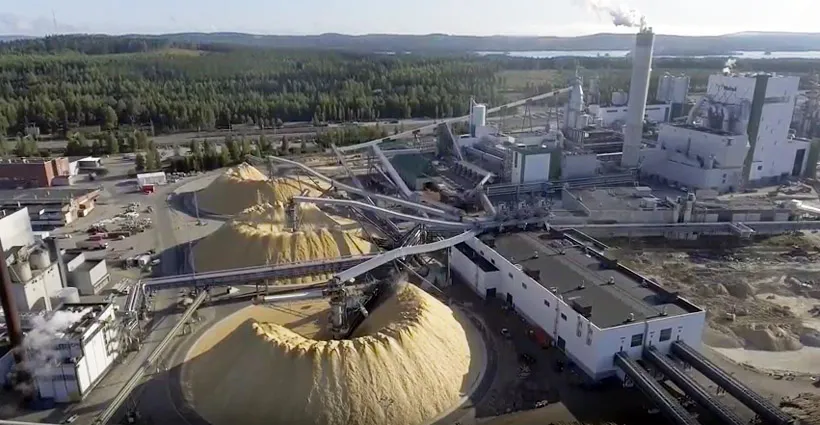Wood exploited to its full potential – The Äänekoski bioproduct mill is the driver of growth in Central Finland

Sometimes opinions change swiftly. Some were already prepared to write off the entire Finnish forestry industry as a thing of the past, despite the fact that the investments of forestry companies – even during the darkest years of financial crisis – were worth more than EUR 500 million every year. That swansong was replaced with happier notes at the latest when Metsä Fibre announced the construction of a new EUR 1 billion bioproduct mill in Äänekoski, Central Finland. The annual pulp production capacity of the mill, inaugurated last August, is 1.3 million tonnes, making the production volumes of the plant more than twice those of the previous plant.
In Finland, another reason to be happy is the high domestic rate of machine purchases, which eventually rose to 70 per cent. This was enabled by the so-called Lex Jordan.
“The Export Credit Guarantee Act was amended three years ago. Before that, it was possible for us to support major companies only by granting export credit for foreign exports. Now we can participate in the investments of major companies even in Finland”, says Satu Savelainen, Finnvera’s account and project manager for the Äänekoski investment.
Finnvera guaranteed a loan of EUR 400 million for the Äänekoski investment. Savelainen says that the investment must promote exports, either directly or indirectly. Metsä Fibre has estimated the project will increase the value of Finnish exports by half a billion euros a year.
“Finnish machine suppliers may now provide quotes with the same terms of financing as their foreign competitors. In the worst case, Metsä Fibre would have maximised its machine purchases from abroad, in which case it could have used the services of local export credit agencies. In such large-scale projects, financing is typically derived from a number of sources. In this project, we collaborated with the Swedish export credit agency EKN”, Savelainen says.
Finnvera’s financing instrument for foreign investments goes by the name of the buyer credit guarantee. It is a guarantee granted to the provider of financing of the export, usually the bank, to secure the risks related to the repayment of the credit. Arranging the financing for the buyer helps the Finnish export company to secure the deal.
A new, similar guarantee arrangement for Finnish investments is called the finance guarantee.
Savelainen says that she currently has several Finnish investment projects on her desk that are similar to the Äänekoski project.
“They come in various sizes and from various industries. At any rate, all these projects are beyond the overture phase.”
Watch the video interview of Metsä Fibre’s President and CEO Ilkka Hämälä and EcoEnergy SF Oy’s CEO Tero Mäki on the Äänekoski project. The interview is in English.
Driving the growth of the entire region
The purpose of the bioproduct mill is to use the byflows of wood processing to their full potential. This means that no landfill waste is generated in the process.
The core of the product offering consists of pulp, pine oil, turpentine, bioelectricity and district heat. Metsä Fibre has announced that the self-sufficiency rate in electricity production in the mill is 240 per cent.
“The mill is a significant driver of growth in Central Finland. About half a dozen other companies have already been established around it, and more businesses that use the byflows of the mill will be created over the next 12 to 18 months, when the production in the mill is ramped up”, says Mikko Vänttinen, Regional Director at Finnvera.
Vänttinen says that the fulfillment of the role of a growth driver is apparent in numerous areas, but particularly in the movements of raw material.
“The mill uses pulpwood, while logwood is redirected to the sawmill industry. Replacement investments at sawmills confirm that the outlook for sawmills has been positive for a long time. The mill also has significant impact on logistics and transport”, Vänttinen continues.
Finnvera may provide financing for investments by SMEs either directly or by granting guarantees.
The regional director also refers to the importance of innovations in the entire forestry cluster. Last year, the forest industry spent more than EUR 100 million on product development in Finland.
“Industries in the traditional sense are losing their importance. In their product development efforts, companies should look beyond the boundaries of different industries”, Vänttinen says.
FACTS: Drivers of exports, the forestry cluster
- Last year, the forest industry exported goods worth EUR 11.5 billion. The proportion of the forest industry of the entire goods exports of Finland was 21.6 per cent.
- Finland is one of the largest producers of pulp, paper and board in the world. The forest industry employs up to 150,000 people in Finland either directly or indirectly.
- The largest concentration of forest industry companies lies between South Karelia and Central Finland. The proportion of the forest industry in the gross value of the manufacturing industry in South Karelia reaches 69 per cent, while the proportion in Central Finland is 35 per cent (the fourth highest figure in the country).
- The vast investment of Metsä Fibre in Äänekoski will increase the future importance of the forest industry in Central Finland. The bioproduct mill cost EUR 1.2 billion. The annual pulp production capacity of the mill is 1.3 million tonnes.
- The mill consumes 4.5 million cubic metres of softwood and 2 million cubic metres of birch each year.
